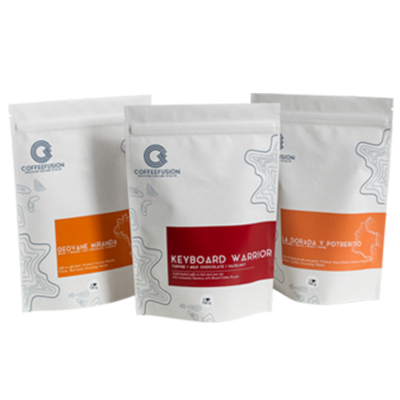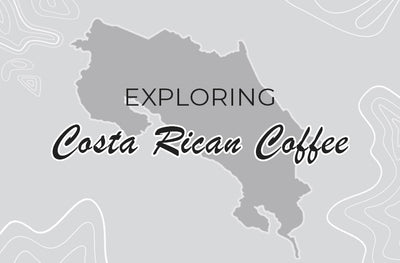Guatemalan coffee is some of the most highly sought-after coffee in the world. With its complex flavour profile and unmatched quality, it's no wonder coffee lovers everywhere are falling in love with Guatemalan beans. But what do you really know about these iconic Central American coffee beans? This guide will take a closer look at it—from the history and processing methods to where to find the best beans.
But, before we get started, allow us to introduce you to our amazing coffee subscription.
Explore our current single origins and blends with our coffee subscription

44 Five Star Reviews
Our coffee subscription let’s you choose your favourite style of coffee and it ensures that you never run out of freshly roasted coffee.
What to expect:
✔ Start with a Free Trial
✔ Pause, modify or cancel at any time
✔ Monthly giveaways for subscribers
✔ Exclusive free brewing videos and other tips
✔ Access to our private Facebook Group
➜ Get started with our Coffee Subscription in Australia
What Makes Guatemalan Coffee Unique?
Guatemala is one of the world's leading producers of coffee, and Guatemalan coffee beans are prized for their distinctively moderately acidic and fruity flavour. Depending on the growing region, they also tend to be very sweet, with chocolate undertones and caramel.
Many factors contribute to the unique character of Guatemalan coffee, including the country's climate, altitude, and soil. Guatemala is located in the so-called "bean belt," a region of the world that straddles the line between the tropics and subtropics. This gives the coffee a more balanced flavour than coffee beans from strictly tropical or temperate areas.

The country's high altitudes and variety of microclimates, from the highlands of Antigua to the volcanic soils of Huehuetenango, also play a role, resulting in slower-growing plants that produce beans with a more concentrated flavour. Finally, the soils of Guatemala are rich in minerals, which impart a characteristic sweetness to the coffee.
All of these factors combined to create truly wonderful coffee beans.
Guatemala Coffee Characteristics
| Growing Altitude | 1,300 - 2,000 meters above sea level |
| Arabica Variety | Typica, Caturra, Bourbon, Catuai, Pache, Maragogipe |
| Harvest Season | November - April |
| Milling Process | Washed, Sun-dried |
| Aroma | Citrus, Sweet floral aroma |
| Flavour | Chocolaty, Sweet, Fruity, Wine, Nutty |
| Body | Full, Balanced |
| Acidity | Bright, Pleasent, Persistent, Intense |
Types of Guatemalan Coffee Beans
Six main varieties of Arabica coffee beans are grown in Guatemala: Typica, Caturra, Bourbon, Catuai, Pache, and Maragogipe.
- Typica: This variety is known for its tall stature, low yield, and high susceptibility to coffee leaf rust. But it's precisely these characteristics that give the Typica more intense flavour and refreshing acidity.
- Caturra: An average-sized, green and compact plant with good yielding potential of standard quality in Central America. It's a natural mutation of the Bourbon variety. High susceptibility to coffee rust.
- Bourbon: It's characterised by excellent cup quality, tall stature, green colour, and relatively low production. Bourbon is susceptible to major diseases, but its cup quality makes it a valuable variety for coffee growers.
- Catuai: Highly susceptible to coffee rust but produces high-quality coffee beans characterised by great vigour and low height with higher yield potential. And due to its small size, it can be planted at almost double the density.
- Pache: A compact, bronze-coloured plant with medium yield potential resulting from a natural mutation of the Typica variety. It's very susceptible to major diseases but has good quality at high altitudes.
- Maragogipe: Some of the largest coffee beans you'll find. The same goes for its leaves and internodes. Although it's susceptible to rust and, therefore, very low yielding, the cup quality is still something between good and very good.
Overview of Guatemala Coffee History
The coffee industry began to develop in Guatemala in the 1850s and 1860s, with German immigrants playing a pivotal role in its introduction. Initially, coffee cultivation was mixed with cochineal, an insect used to produce a red dye.
However, coffee became the dominant crop over time, and small coffee plantations flourished in the Amatitlán and Antigua areas. Though initial growth was slow due to a lack of knowledge and technology, the industry eventually thrived.
Back in the day, many planters had to rely on loans and borrow from their families to finance their coffee estates, with coffee production in Guatemala increasingly owned by foreign companies with capital to buy plantations and invest.
Guatemala Coffee Regions
You may be wondering, "Where does Guatemalan coffee come from?" There are about eight Guatemalan coffee regions where delicious coffee beans are best grown: Acatenango Valley, Antigua Coffee, Traditional Atitlán, Rainforest Cobán, Fraijanes Plateau, Highland Huehuetenango, Nuevo Oriente, and Volcanic San Marcos.
Let's take a closer look at each of them.

1. Acatenango Valley
Acatenango-rich, sandy soils are constantly replenished with minerals from the nearby Fuego volcano. The high altitude (up to 2,000 meters) creates a dense forest canopy that protects the coffee trees from the harsh sun. The temperate winds from the Pacific Ocean also help dry the coffee cherries, resulting in a well-balanced coffee with complex flavour notes.
Coffee growing region profile:
- Temperature: 14 - 31ºC
- Precipitation: 1,219 - 1,829 mm
- Humidity: 70 - 80%
- Altitude: 1,311 - 1,981 meters
2. Antigua Coffee
The region's low humidity, rich volcanic soil, and exposure to lots of sun and cool nights create ideal growing conditions for coffee plants. The dense shade given by the region's trees protects the coffee plants from periodic frosts. The area's three volcanoes - Agua, Fuego, and Acatenango - provide a regular dusting of mineral-rich ash that enriches the soil. Antigua coffee is known for its smooth, balanced flavour with notes of chocolate and caramel.
Coffee growing region profile:
- Temperature: 18 - 22ºC
- Precipitation: 813 - 1,219 mm
- Humidity: 65%
- Altitude: 1,524 - 1,707 meters
3. Traditional Atitlán
The three volcanoes that overlook Lake Atitlán - Toliman, Atitlan, and San Pedro - play a role in the microclimate, and the daily winds (Xocomil) help to stir the cold waters of the lake. This creates an ideal growing environment for the Atitlan coffee cultivated on the slopes of these volcanoes. The rich soil and ideal climate conditions produce delightfully aromatic beans with a bright citrus acidity and full body.
Coffee growing region profile:
- Temperature: 20 - 22ºC
- Precipitation: 1,829 - 2,337 mm
- Humidity: 75 - 85%
- Altitude: 1,524 - 1,707 meters
4. Rainforest Cobán
Cobán is a region shrouded in mist and cloud cover for much of the year, creating ideal conditions for coffee plants to thrive. Most of this coffee is grown on rolling hills, under the tropical influences of the Atlantic Basin. And the soil here is rich in limestone and clay, helping promote a high level of acidity. Cobán's signature chipi-chipi frequently engulfs the region in a fine mist that falls from the dense cloud cover, giving the coffee fresh fruit notes.
The resulting beans have a distinctive flavour that is a far stretch from other sunny volcanic regions. Subtle, well-balanced body and a pleasant aroma.
Coffee growing region profile:
- Temperature: 15 - 20ºC
- Precipitation: 3,048 - 4,064 mm
- Humidity: 85 - 95%
- Altitude: 1,311 - 1,707 meters
5. Fraijanes Plateau
The region's volcanic pumice soil, high altitudes, plenty of rain, and variable humidity create ideal growing conditions for coffee plants. And the Fraijanes's active volcano, Pacaya, regularly supplies the soil with a light deposit of ash, giving the coffee beans a boost of minerals. This plateau also has a long dry season with sun.
Although clouds, fog, and heavy dew are common in the early morning, they quickly burn off, allowing all coffee cherries to be sun-dried. As a result, Fraijanes coffee beans are well-balanced, with bright acidity and sweet mouthfeel.
Coffee growing region profile:
- Temperature: 12 - 26ºC
- Precipitation: 1,524 - 3,048 mm
- Humidity: 70 - 90%
- Altitude: 1,372 - 1,829 meters

6. Highland Huehuetenango
Nestled in the country's highlands, it's the highest and driest region under cultivation. The region's warm, dry winds provide protection from frost, allowing growers to cultivate coffee at high elevations. Because of its location, most coffee producers process their own coffee. However, the region's rivers and streams provide an ample water supply for milling operations. Huehuetenango coffee beans are known for their fine acidity, full-body, and wine-like notes.
Coffee growing region profile:
- Temperature: 20 - 24ºC
- Precipitation: 1,219 - 1,422 mm
- Humidity: 70 - 80%
- Altitude: 1,524 - 1,981 meters
7. Nuevo Oriente
Nuevo Oriente region has been producing coffee since the 50s, and nowadays, almost every single farm on the mountain is dedicated to growing coffee beans. This was once one of Guatemala's poorest and most isolated areas, but thanks to the booming coffee industry, it has transformed into a thriving community. The region gets its unique flavour profile from its rain-drenched and cloudy climate and its metamorphic (mineral-rich) soils, resulting in a balanced and full-bodied coffee with a chocolatey flavour profile.
Nuevo Oriente coffee growing region profile:
- Temperature: 18 - 25ºC
- Precipitation: 1,829 - 2,032 mm
- Humidity: 70 - 80%
- Altitude: 1,311 - 1,707 meters
8. Volcanic San Marcos
The warmest of all the regions, San Marcos also experiences the highest rainfall levels, reaching up to 5,000 mm annually. The rains tend to come sooner than in other areas, which results in the earliest flowering. Small coffee farms with their own processing plants produce the majority of Volcanic San Marcos.
And because of the unpredictable nature of the weather during harvest season, much of the coffee is pre-dried in the sun and then finished in a Guardiola dryer. This results in delicate floral notes in the aroma and taste, as well as pronounced acidity and a good body.
Coffee growing region profile:
- Temperature: 21 - 27ºC
- Precipitation: 4,063 - 5,080 mm
- Humidity: 70 - 80%
- Altitude: 1,311 - 1,829 meters
What Does Guatemala Coffee Taste Like?
Depending on the region, Guatemala's coffee taste can have floral and citrus aromas, with chocolate, sweet, fruity, wine or nutty flavours. This coffee is also known for its full and balanced body, as well as its bright, pleasant, persistent and intense acidity. All of these elements combined craft an unforgettable cup of coffee. When made correctly, it's an incredibly nuanced and complex beverage.

Guatemala Coffee Production and Export
The country's coffee industry began in the early 1850s, and today it's an essential component of its economy. Most of the country's coffee is grown on small family coffee farms, typically harvested by hand. After being picked, the beans are then wet-processed to remove the fruit before being sun-dried and roasted.
During the 2019-2021 period, Guatemala's coffee industry exported 3,441,000 bags (60kg each). We're talking about a total export weight of 206,460,000 kg – tons of coffee.
A Global Agricultural Information Network report states that the vast majority of Guatemala's coffee exports are destined for the United States (49%). Other popular destinations include Japan (16%), Canada, and Germany. Now, in terms of Guatemala's coffee production, these are the numbers according to the exhaustive work of the World Coffee Research:
- Global export rank: #10
- Annual export volume: 3,269
- % Arabica vs. Robusta:27%
- Number of coffee farms: 175,100
- Total cultivated area: 308,217
- All-agriculture R&D intensity:14
- Coffee produced by smallholders: 44%
- Smallholder productivity: 702
- Average smallholder farm size:1 Hectares
The next time you enjoy a cup of fine Guatemalan coffee beans, remember that it's more than just a delicious beverage - it's also a key part of Guatemala's history and culture.
Best Brew Methods for Guatemalan Coffee
Great coffee must have great brew methods. Here are three ways to brew Guatemalan coffee beans. Experiment and find the method that you like best. Share your personal favourite brewing technique in the comments section, and tell us why!
Pour Over
Just grind your beans and then put them in a filter. Slowly pour hot water over the beans, letting them drip into your cup or carafe. This allows the coffee grounds to bloom and release their aromatics, resulting in a cup of coffee that is full of flavour. The pour-over is great if you want to control the strength of your coffee. Just experiment with different grind sizes and water-to-bean ratios until you find something you like.
French Press
This is a more immersive way to brew coffee, and it really lets the beans' flavours shine through. Just grind your beans and add them to the press along with some hot water. Leave it for a few minutes to steep, and then press down on the plunger to filter out the grounds. The resulting coffee will be somewhat stronger than a pour-over but still very smooth and flavorful.
Cold Brew
This is perfect for hot summer days. Just grind your beans and add them to a container of cold water. Leave it in the fridge for 12 hours or more, and then strain out the grounds. Cold brew coffee is very strong but also very smooth and low in acidity.
Where to Buy Guatemala Coffee Beans In Your Area?
If you're looking for a unique coffee experience, Guatemalan coffee beans are worth exploring. With a distinct flavour profile, notes, and a wide variety of growing regions, there's something for everyone who wants to taste this coffee. And if you're not sure where to start, we've got you covered! Our coffee subscription will send fresh beans from some of the best growers. We ship freshly roasted beans right to your door, so you can enjoy the best-tasting cup of Guatemalan coffee possible. Start your journey into the world of Guatemalan coffee.
Other Coffee Regions You Might Want to Explore
➜ Ultimate Guide about Costa Rican Coffee










Leave a comment
Please note, comments must be approved before they are published